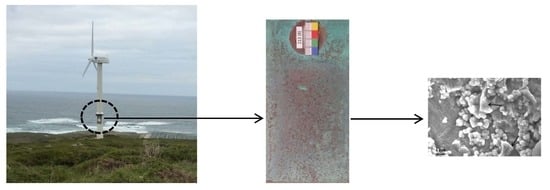Corrosion of Copper in Unpolluted Chloride-Rich Atmospheres
Abstract
1. Introduction
2. Materials and Methods
2.1. Environmental Characteristics of the Atmospheric Testing Site: Cabo Vilano Wind Farm (Galicia, Spain)
2.2. Testing Stations
2.3. Test Specimens
2.4. Evaluation of Corrosion Rates
2.5. Nature of the Corrosion Products Formed
2.6. Coverage of the Cuprite Surface by Basic Copper Chlorides (Cu2(OH)3Cl)
2.7. Morphology of the Patinas Formed
3. Results
3.1. Corrosion Rates
3.2. Nature of the Corrosion Products Formed
3.3. Coverage of the Cuprite Surface by Basic Copper Chlorides (Cu2(OH)3Cl)
4. Discussion
4.1. Formation of a Cuprite Film
4.2. Interaction of the Cuprite Layer with Marine Aerosol
- (a)
- as nantokite (CuCl):Cu+ + Cl− → CuCl
- (b)
- as cuprite (Cu2O), by the reaction of the cuprous ions with the hydroxyl ions from the cathodic reaction, as indicated in reaction (4) or
- (c)
- form chlorinated complexes of Cu+:CuCl + Cl− → CuCl2−
4.3. Formation of Basic Copper Chlorides
4.4. Flaking of Basic Chloride Layers Present on the Cuprite Film
5. Conclusions
- -
- The copper corrosion rate may initially (three months of exposure) reach very high values (11.70 μm/year) at sites close to the seashore (332 m), notably decreasing further inland (1250 m) in the studied coastal region (4.29 μm/year). The corrosion rate also decreases as the exposure time advances. After 12 months of exposure, corrosion rates decrease to 4.21 and 1.74 μm/year, respectively.
- -
- The patinas formed on copper are comprised by the following phases: cuprite (Cu2O) and the polymorphs of basic chlorides (Cu2(OH)3Cl): botallackite, atacamite and clinoatacamite. Due to the instability of nantokite (CuCl) it was not possible to identify this phase by XRD.
- -
- The greater or lesser coverage of the cuprite film by basic chlorides (pleasant turquoise blue appearance) depends on the atmospheric chloride deposition rate and the exposure time of copper in the coastal atmosphere. In the atmosphere with the highest chloride deposition rate (1640 mg/m2/day) the coverage percentage after three months of exposure already reached 80%, arriving at 100% coverage after one year of exposure. In contrast, for lower atmospheric salinity levels (~100 mg Cl−/m2/day) the coverage percentage was very low (1–4%) and the patina formed maintained the characteristic reddish color of the cuprite film.
- -
- Information obtained by GIXRD confirms the location of the cuprite phase in the innermost region of the patina. In view of the greater relative increase in the proportion of clinoatacamite encountered when using GIXRD, compared to the proportions found with conventional XRD, it may be speculated that this phase preferentially comprises the outermost region of the patina. Moreover the smaller size of the atacamite phase crystallites, as deduced from the XRD peak profile analysis, suggests that this phase is preferentially located in intermediate strata of the patina.
- -
- At high chloride deposition rates in the marine atmosphere, the outer patina of basic chlorides cracks and flakes off locally, making it possible to observe the inner cuprite film. The greater average molar volume of the basic chlorides compared to cuprite would in itself explain the physical stresses developed at the cuprite/basic copper chlorides interface, which would lead to the cracking and flaking off of the loosely adherent outer patina preferentially integrated by the latter.
Author Contributions
Funding
Acknowledgments
References
- Henriksen, J.; Hienonen, R.; Imrell, T.; Leygraf, C.; Sjögren, L. Corrosion of Electronics; Bulletin No. 102; Swedish Corrosion Institute: Stockholm, Sweden, 1991. [Google Scholar]
- Graedel, T.E.; Franey, J.P. The Statue of Liberty Restoration; Baboian, R., Bellante, B.I., Cliver, E.B., Eds.; NACE: Houston, TX, USA, 1990. [Google Scholar]
- Graedel, T.E.; Nassau, K.; Franey, J.P. Copper patinas formed in the atmosphere—I. Introduction. Corros. Sci. 1987, 27, 639–657. [Google Scholar] [CrossRef]
- Fitzgerald, K.P.; Nairn, J.; Atrens, A. The chemistry of copper patination. Corros. Sci. 1998, 40, 2029–2050. [Google Scholar] [CrossRef]
- Fitzgerald, K.P.; Nairn, J.; Skennerton, G.; Atrens, A. Atmospheric corrosion of copper and the colour, structure and composition of natural patinas on copper. Corros. Sci. 2006, 48, 2480–2509. [Google Scholar] [CrossRef]
- Leygraf, C.; Odnevall Wallinder, I.; Tidblad, J.; Graedel, T. Atmospheric Corrosion, 2nd ed.; Wiley Blackwell: Hoboken, NJ, USA, 2016; pp. 1–374. [Google Scholar] [CrossRef]
- Chang, T.; Wallinder, I.O.; de la Fuente, D.; Chico, B.; Morcillo, M.; Welter, J.M.; Leygraf, C. Analysis of Historic Copper Patinas. Influence of Inclusions on Patina Uniformity. Materials 2017, 10, 298. [Google Scholar] [CrossRef] [PubMed]
- Morcillo, M.; Chang, T.; Chico, B.; de la Fuente, D.; Odnevall Wallinder, I.; Jiménez, J.A.; Leygraf, C. Characterisation of a centuries-old patinated copper roof tile from Queen Anne’s Summer Palace in Prague. Mater. Charact. 2017, 133, 146–155. [Google Scholar] [CrossRef]
- Wallinder, I.O.; Korpinen, T.; Sundberg, R.; Leygraf, C. Atmospheric corrosion of naturally and pre-patinated copper roofs in Singapore and Stockholm—Runoff rates and corrosion product formation. In Outdoor and Indoor Atmospheric Corrosion; Townsend, H.E., Ed.; ASTM International: West Conshohocken, PA, USA, 2002; pp. 230–244. [Google Scholar]
- Kucera, V.; Mattsson, E. Atmospheric corrosion. In Corrosion Mechanism; Dekker, M., Ed.; Marcel Dekker: New York, NY, USA, 1987; pp. 211–284. [Google Scholar]
- De la Fuente, D.; Simancas, J.; Morcillo, M. Morphological study of 16-year patinas formed on copper in a wide range of atmospheric exposures. Corros. Sci. 2008, 50, 268–285. [Google Scholar] [CrossRef]
- Hedberg, Y.S.; Hedberg, J.F.; Herting, G.; Goidanich, S.; Odnevall Wallinder, I. Critical Review: Copper Runoff from Outdoor Copper Surfaces at Atmospheric Conditions. Environ. Sci. Technol. 2014, 48, 1372–1381. [Google Scholar] [CrossRef] [PubMed]
- Strandberg, H. Reactions of copper patina compounds—I. Influence of some air pollutants. Atmos. Environ. 1998, 32, 3511–3520. [Google Scholar] [CrossRef]
- United Nations Economic Commission for Europe (UN/ECE). Effects of Sulphur Compounds on Materials, Including Historic and Cultural Monuments, Airborne Sulphur Pollution. Effects and Control; United Nations Economic Commission for Europe (UN/ECE): New York, NY, USA, 1984. [Google Scholar]
- United Nations Economic Commission for Europe (UN/ECE). International Cooperative Programme (ICP) on Materials including Historic and Cultural Monuments, Convention of Long-Range Transboundary Air Pollution (CLRTAP); United Nations Economic Commission for Europe: Geneva, Switzerland, 1998. [Google Scholar]
- Krätschmer, A.; Odnevall Wallinder, I.; Leygraf, C. The evolution of outdoor copper patina. Corros. Sci. 2002, 44, 425–450. [Google Scholar] [CrossRef]
- Watanabe, M.; Tomita, M.; Ichino, T. Characterization of Corrosion Products Formed on Copper in Urban, Rural/Coastal, and Hot Spring Areas. J. Electrochem. Soc. 2001, 148, B522–B528. [Google Scholar] [CrossRef]
- Veleva, L.; Quintana, P.; Ramanauskas, R.; Pomes, R.; Maldonado, L. Mechanism of copper patina formation in marine environments. Electrochim. Acta 1996, 41, 1641–1645. [Google Scholar] [CrossRef]
- Strandberg, H.; Johansson, L.G. Some Aspects of the Atmospheric Corrosion of Copper in the Presence of Sodium Chloride. J. Electrochem. Soc. 1998, 145, 1093–1100. [Google Scholar] [CrossRef]
- Núñez, L.; Reguera, E.; Corvo, F.; González, E.; Vazquez, C. Corrosion of copper in seawater and its aerosols in a tropical island. Corros. Sci. 2005, 47, 461–484. [Google Scholar] [CrossRef]
- Corvo, F.; Perez, T.; Dzib, L.R.; Martin, Y.; Castañeda, A.; Gonzalez, E.; Perez, J. Outdoor–indoor corrosion of metals in tropical coastal atmospheres. Corros. Sci. 2008, 50, 220–230. [Google Scholar] [CrossRef]
- Veleva, L.; Farro, W. Influence of seawater and its aerosols on copper patina composition. Appl. Surf. Sci. 2012, 258, 10072–10076. [Google Scholar] [CrossRef]
- Portella, M.O.G.; Portella, K.F.; Pereira, P.A.M.; Inone, P.C.; Brambilla, K.J.C.; Cabussú, M.S.; Cerqueira, D.P.; Salles, R.N. Atmospheric Corrosion Rates of Copper, Galvanized Steel, Carbon Steel and Aluminum in the Metropolitan Region of Salvador, BA, Northeast Brazil. Procedia Eng. 2012, 42, 171–185. [Google Scholar] [CrossRef]
- Lin, H.; Frankel, G.S. Atmospheric Corrosion of Cu during Constant Deposition of NaCl. J. Electrochem. Soc. 2013, 160, C336–C344. [Google Scholar] [CrossRef]
- Castañeda, A.; Corvo, F.; Fernández, D.; Valdés, C. Outdoor-indoor atmospheric corrosion in a coastal wind farm located in a tropical Island. Eng. J. 2017, 21, 43. [Google Scholar] [CrossRef]
- Morcillo, M.; Almeida, E.; Marrocos, M.; Rosales, B. Atmospheric Corrosion of Copper in Ibero-America. Corrosion 2001, 57, 967–980. [Google Scholar] [CrossRef]
- Knotkova, D.; Kreislova, K.; Sheldon, S.D., Jr. International Atmospheric Exposure Program: Summary of Results; ASTM Data Series 71; ASTM International: West Conshohocken, PA, USA, 2016. [Google Scholar]
- Odnevall Wallinder, I.; Zhang, X.; Goidanich, S.; Le Bozec, N.; Herting, G.; Leygraf, C. Corrosion and runoff rates of Cu and three Cu-alloys in marine environments with increasing chloride deposition rate. Sci. Total Environ. 2014, 472, 681–694. [Google Scholar] [CrossRef] [PubMed]
- Zhang, X.; Odnevall Wallinder, I.; Leygraf, C. Mechanistic studies of corrosion product flaking on copper and copper-based alloys in marine environments. Corros. Sci. 2014, 85, 15–25. [Google Scholar] [CrossRef]
- Graedel, T.E. Copper patinas formed in the atmosphere—II. A qualitative assessment of mechanisms. Corros. Sci. 1987, 27, 721–740. [Google Scholar] [CrossRef]
- Morcillo, M.; Almeida, E.; Rosales, B.; Uruchurtu, J.; Marrocos, M. Corrosión y Protección de Metales en las Atmósferas de Iberoamérica. Parte I: Mapas de Iberoamérica de Corrosividad Atmosférica (Proyecto MICAT, XV.1/CYTED); CYTED: Madrid, Spain, 1998. [Google Scholar]
- International Organization for Standardization. ISO 9225:2012, Corrosion of Metals and Alloys—Corrosivity of Atmospheres—Measurement of Environmental Parameters Affecting Corrosivity of Atmospheres; International Organization for Standardization: Geneva, Switzerland, 2012. [Google Scholar]
- Alcántara, J.; Chico, B.; Díaz, I.; de la Fuente, D.; Morcillo, M. Airborne chloride deposit and its effect on marine atmospheric corrosion of mild steel. Corros. Sci. 2015, 97, 74–88. [Google Scholar] [CrossRef]
- German Institute for Standardization. DIN EN 13599—Copper and Copper Alloys—Copper Plate, Sheet and Strip for Electrical Purposes; German Institute for Standardization: Berlin, Germany, 2014. [Google Scholar]
- ASTM International. ASTM G1-90 Standard Practice for Preparing, Cleaning, and Evaluation Corrosion Test Specimens; ASTM International: West Conshohocken, PA, USA, 1999. [Google Scholar]
- International Organization for Standardization. ISO 9226:2012 Corrosion of Metals and Alloys—Corrosivity of Atmospheres—Determination of Corrosion Rate of Standard Specimens for the Evaluation of Corrosivity; International Organization for Standardization: Geneva, Switzerland, 2012. [Google Scholar]
- ASTM International. Pearson’s Crystal Structure, Database for Inorganic Compounds; ASTM International: West Conshohocken, PA, USA, 2015. [Google Scholar]
- ImageJ Image Processing and Analysis in Java. Available online: https://imagej.nih.gov/ij/ (accessed on 1 July 2018).
- Pollard, A.M.; Thomas, R.G.; Williams, P.A. Synthesis and Stabilities of the Basic Copper(II) Chlorides Atacamite, Paratacamite and Botallackite. Mineral. Mag. 1989, 53, 557–563. [Google Scholar] [CrossRef]
- Frost, R.L. Raman spectroscopy of selected copper minerals of significance in corrosion. Spectrochim. Acta Part A 2003, 59, 1195–1204. [Google Scholar] [CrossRef]
- Slamova, K.; Duerr, I.; Kaltenbach, T.; Koehl, M. Degradation effects of maritime atmosphere on metallic components of solar collectors. Sol. Energy Mater. Sol. Cells 2016, 147, 246–254. [Google Scholar] [CrossRef]
- Jambor, J.L.; Dutrizac, J.E.; Roberts, A.C.; Grice, J.D.; Szymanski, J.T. Clinoatacamite, a new polymorph of Cu2(OH)3Cl, and its relationship to paratacamite and “anarakite”. Can. Mineral. 1996, 34, 61–72. [Google Scholar]
- Malcherek, T.; Schlüter, J. The crystal structure of clinoatacamite and the quest for paratacamite. In Proceedings of the Poster Annual Meeting of DMG, Berlin, Germany, 29 May–2 June 2008. [Google Scholar]
- Cathcart, A. Discussion on the open-air corrosion of copper. III—Artificial production of green patina. J. Inst. Met. 1932, 49, 161. [Google Scholar]
- Mattsson, E.; Holm, R. Copper and Copper alloys. In ASTM STP 435; ASTM International: West Conshohocken, PA, USA, 1968; pp. 187–210. [Google Scholar]
- Rice, D.W.; Peterson, P.; Rigby, E.B.; Phipps, P.B.P.; Cappell, R.J.; Tremoureux, R. Atmospheric Corrosion of Copper and Silver. J. Electrochem. Soc. 1981, 128, 275–284. [Google Scholar] [CrossRef]
- Kubaschewski, O.; Hopkins, B.E. Oxidation of Metals and Alloys; Butterworths Scientific Publications: London, UK, 1953. [Google Scholar] [CrossRef]
- Odnevall Wallinder, I.; Leygraf, C. Seasonal variations in corrosion rate and runoff rate of copper roofs in an urban and a rural atmospheric environment. Corros. Sci. 2001, 43, 2379–2396. [Google Scholar] [CrossRef]
- Drogowska, M.; Brossard, L.; Menard, H. Copper dissolution in NaHCO3 and NaHCO3 + NaCl aqueous solutions at pH 8. J. Electrochem. Soc. 1992, 139, 39–47. [Google Scholar] [CrossRef]
- Franey, J.P.; Davis, M.E. Metallographic studies of the copper patina formed in the atmosphere. Corros. Sci. 1987, 27, 659–668. [Google Scholar] [CrossRef]
- Scholes, I.R.; Jacob, W.R. Atmospheric corrosion of copper and copper-base alloys during twenty years’ exposure in a marine and industrial environment. J. Inst. Met. 1970, 98, 272–280. [Google Scholar]
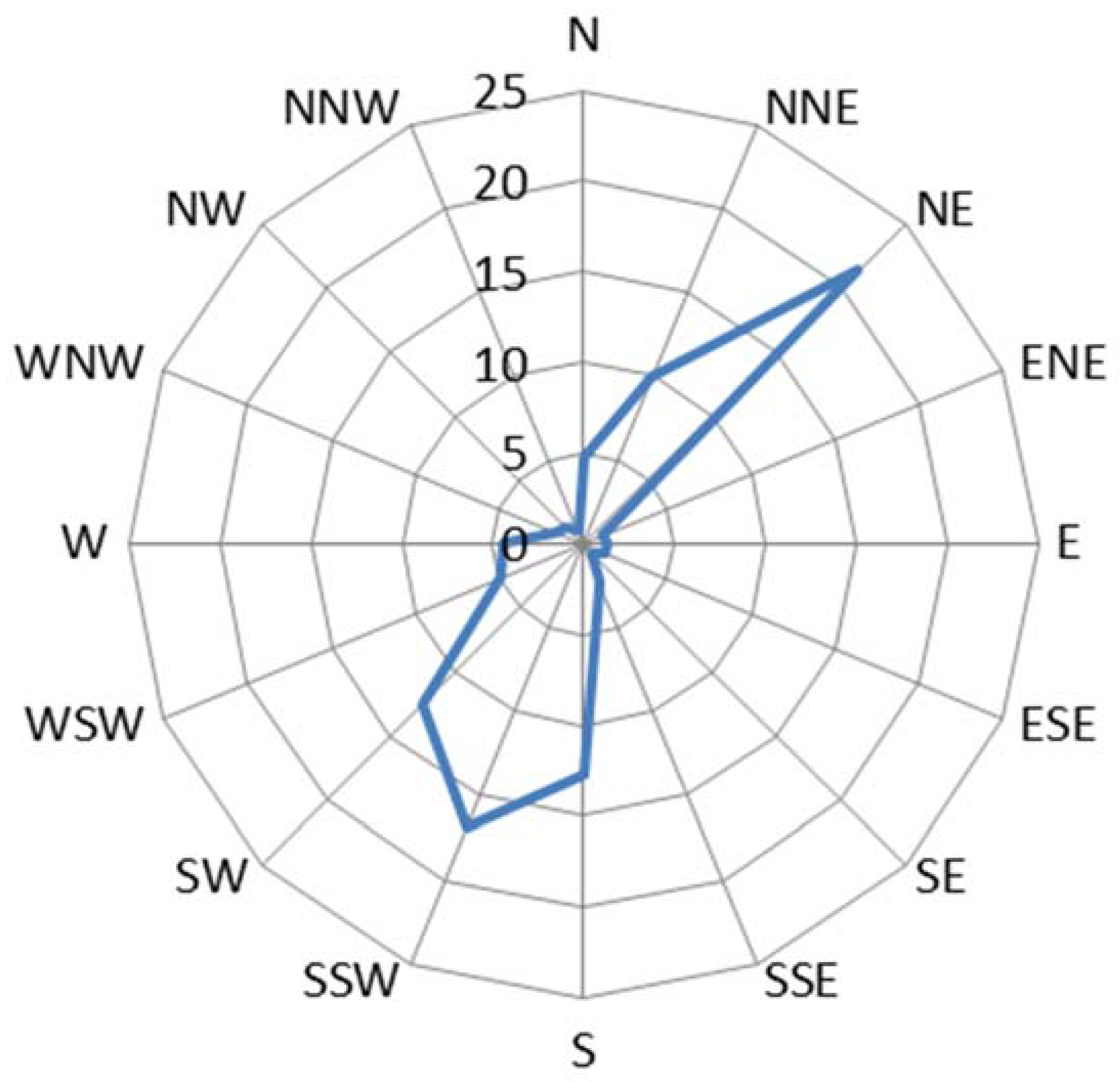

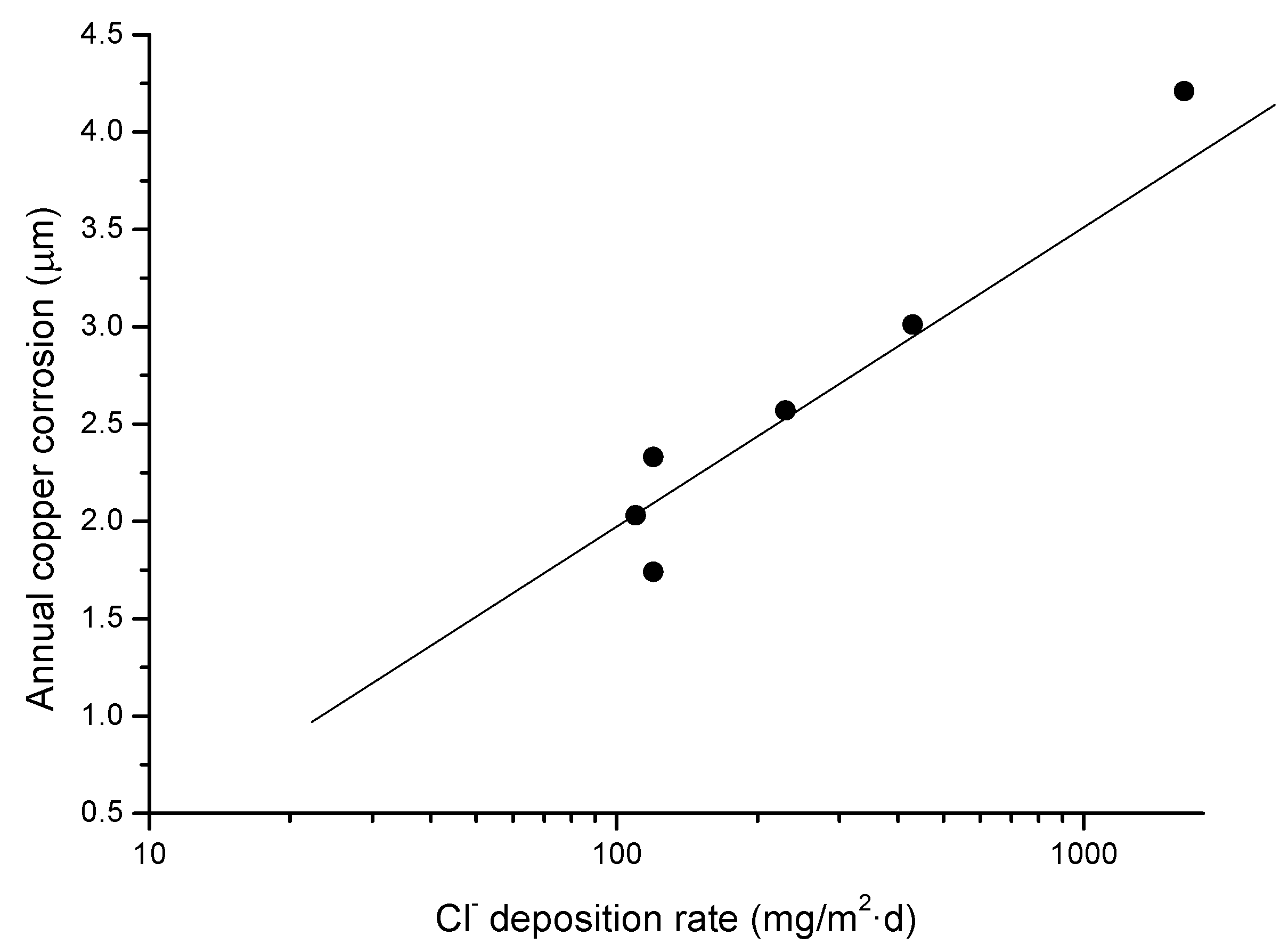

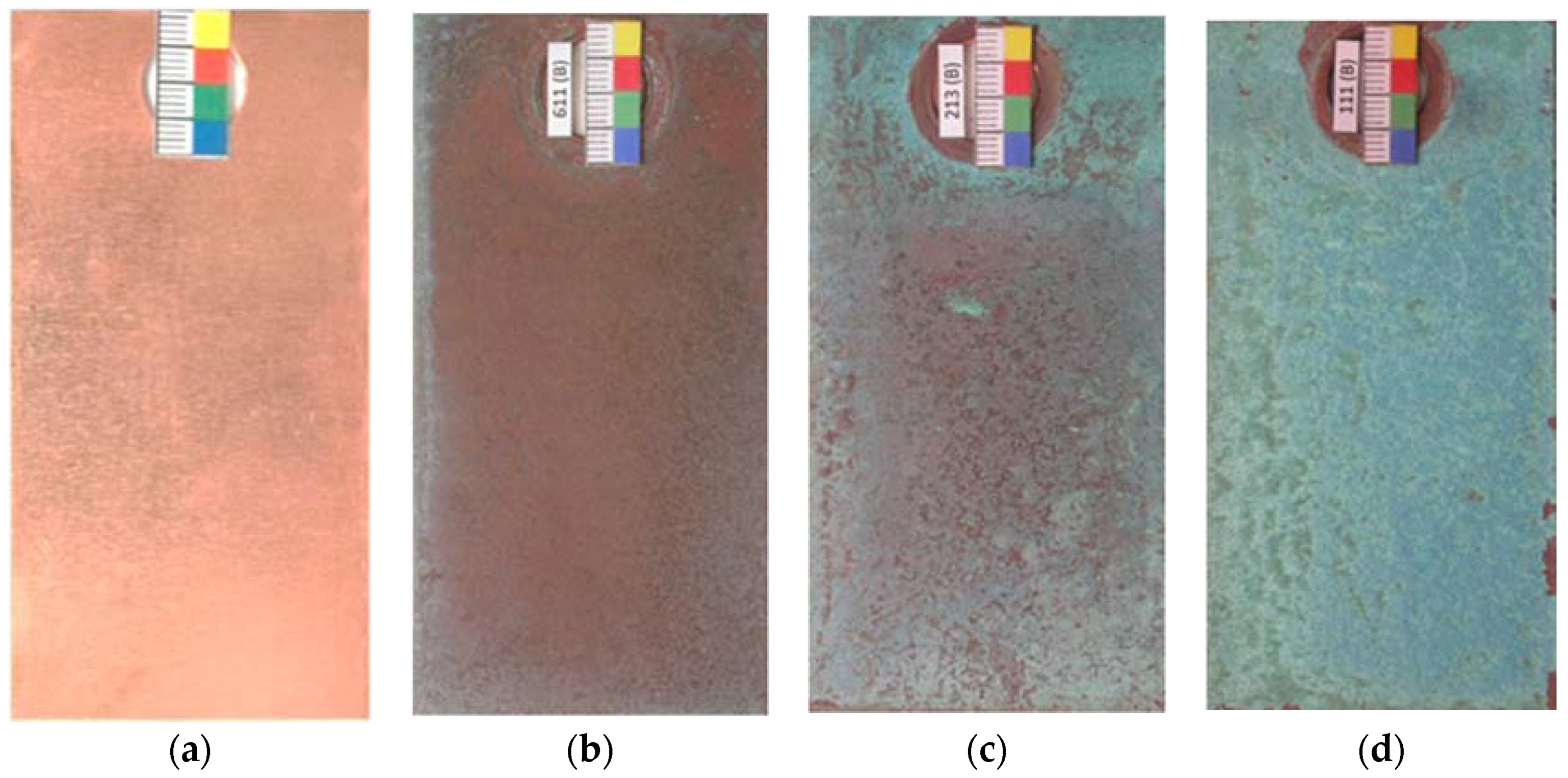


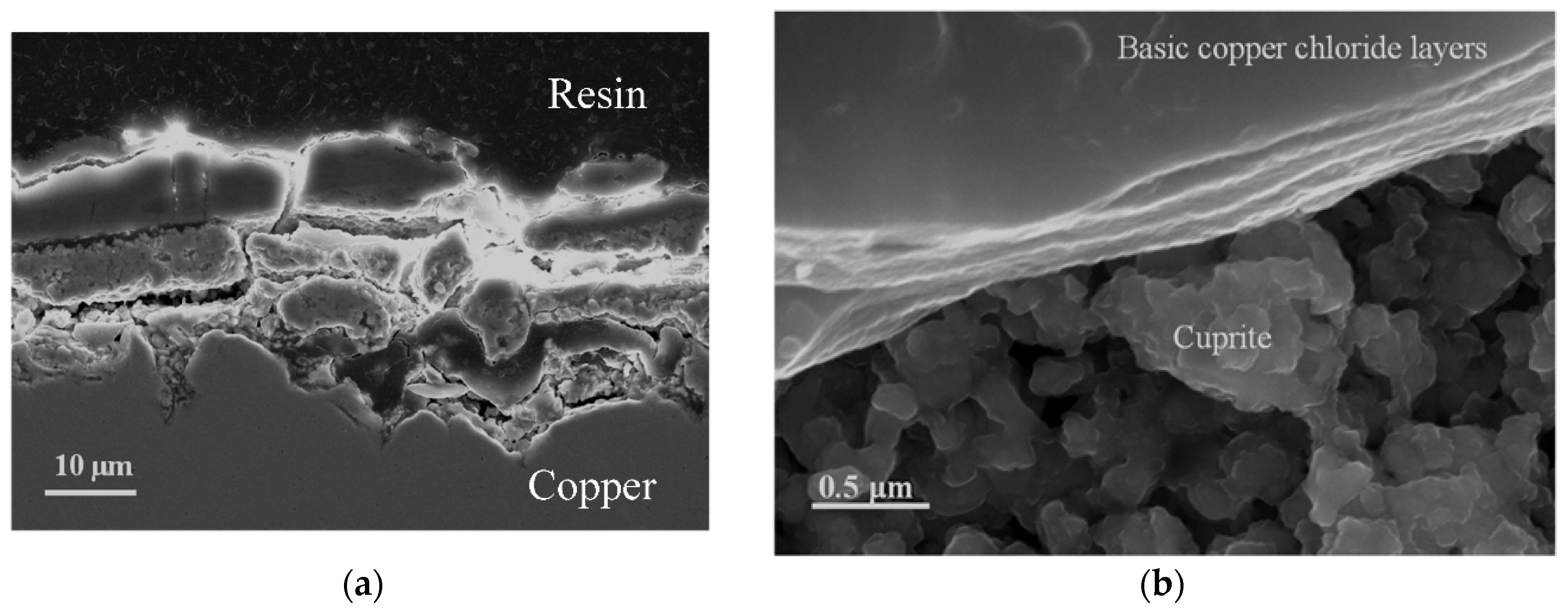
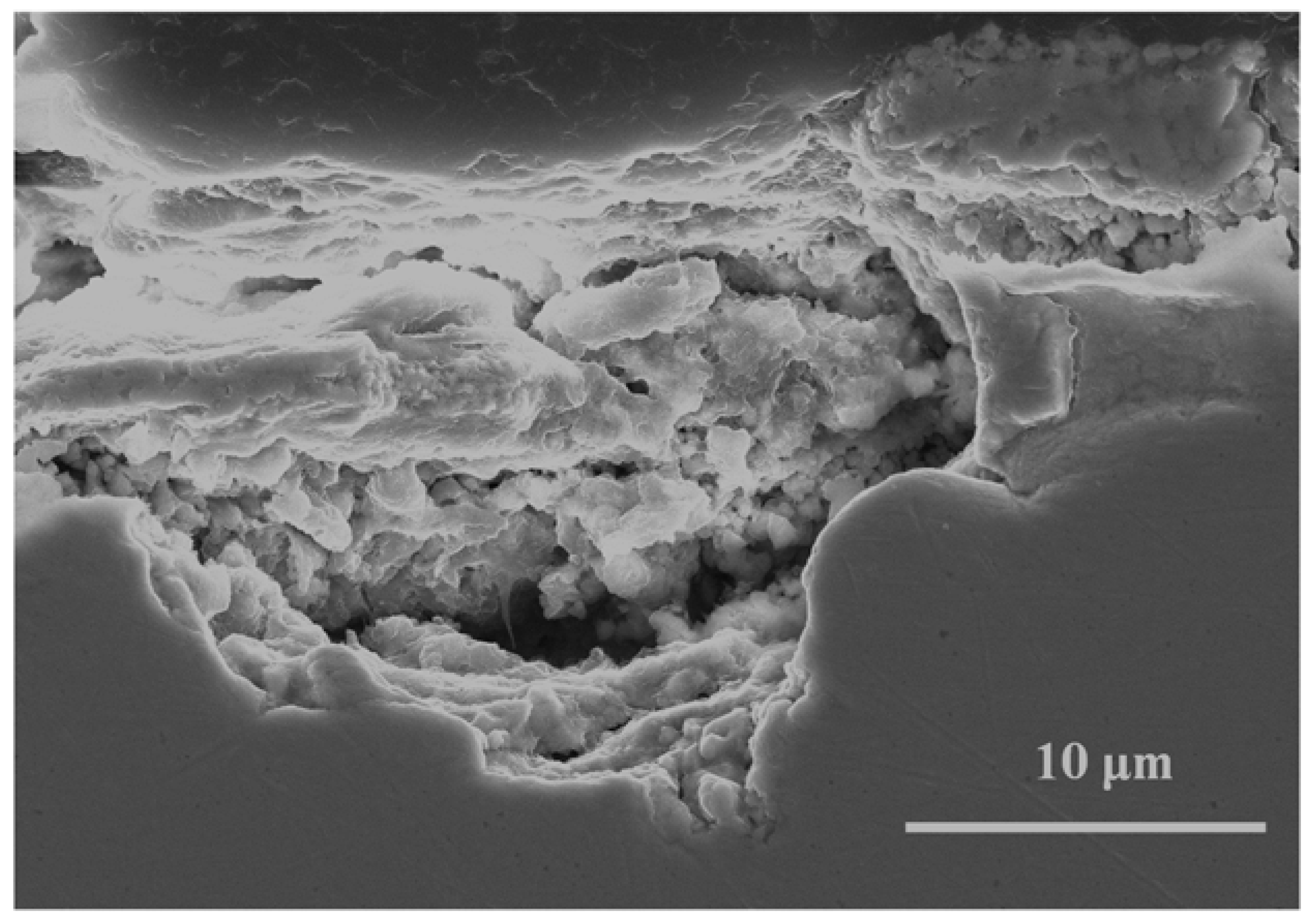

| Ref. | Test Site | Country | Cl− Deposition Rate, (mg Cl−/m2·d) | First-Year Corrosion, (μm) |
|---|---|---|---|---|
| [31] | Sabanilla | Costa Rica | 11.3 | 1.2 |
| [27] | Vladivostok | Russia | 11.8 | 1.4 |
| [27] | Murmansk | Russia | 12.1 | 1.7 |
| [31] | Matanzas | Venezuela | 15.9 | 1.0 |
| [31] | Acapulco | Mexico | 23.8 | 1.2 |
| [31] | S. Cristobal | Ecuador | 25.0 | 1.5 |
| [31] | Coro | Venezuela | 27.5 | 2.4 |
| [27] | Camet | Argentina | 28.7 | 2.2 |
| [31] | Punto Fijo | Venezuela | 31.0 | 3.2 |
| [31] | Puntarenas | Costa Rica | 33.4 | 3.0 |
| [27] | Choshi | Japan | 40.5 | 1.4 |
| [31] | Salinas | Ecuador | 47.3 | 2.3 |
| [27] | Kattesand | Sweden | 51.9 | 1.7 |
| [31] | Camet | Argentina | 55.1 | 2.2 |
| [27] | Okinawa | Japan | 78.9 | 2.1 |
| [28] | Brest (S.2) | France | ~80.0 | 1.8 |
| [27] | Kure Beach | USA | 112.0 | 2.9 |
| [31] | Ubatuba | Brazil | 113.0 | 3.3 |
| [31] | P. del Este | Uruguay | 144.0 | 2.5 |
| [27] | Tannager | Norway | 182.9 | 1.9 |
| [31] | Limón | Costa Rica | 220.0 | 3.7 |
| [31] | A. do Cabo | Brazil | 229.0 | 2.5 |
| [27] | Kvarnvik | Sweden | 404.9 | 2.8 |
| [28] | Brest (S.1) | France | ~500.0 | 2.7 |
| Phase | JCPDS Card | Reflection (hkl) | Peak Position (2θ) |
|---|---|---|---|
| Atacamite | 025-0269 | (011) | 18.789 |
| Paratacamite | 025-1427 | (−110) | 18.928 |
| Clinoatacamite | 050-1559 | (−101) (011) | 18.823 |
| Botallactite | 008-0088 | (001) | 18.186 |
| Nantokite | 006-0344 | (111) | 33.243 |
| Test Site (Figure 2) | Corrosion Rate (μm/year) | |||
|---|---|---|---|---|
| 3 Months | 6 Months | 9 Months | 12 Months | |
| 1 | 11.70 ± 1.14 | 7.56 ± 0.87 | 6.83 ± 0.12 | 4.21 ± 0.22 |
| 2 | 7.64 ± 0.32 | 5.17 ± 0.10 | 3.95 ± 0.11 | 3.01 ± 0.02 |
| 3 | 6.31 ± 0.02 | 4.42 ± 0.06 | 3.31 ± 0.09 | 2.57 ± 0.01 |
| 4 | 6.11 ± 0.05 | 4.03 ± 0.11 | 3.10 ± 0.07 | 2.33 ± 0.03 |
| 5 | 5.18 ± 0.04 | 3.44 ± 0.06 | 2.59 ± 0.06 | 2.03 ± 0.03 |
| 6 | 4.29 ± 0.14 | 3.12 ± 0.08 | 2.10 ± 0.05 | 1.74 ± 0.04 |
| Test Site (Figure 2) | Time of Exposure (Months) | XRD | Cuprite | Basic Copper Chlorides | ||
|---|---|---|---|---|---|---|
| Botallackite | Atacamite | Clinoatacamite | ||||
| 1 | 9 | conventional | 64.4 | 1.1 | 21.9 | 12.6 |
| GIXRD | 25.5 | 1.3 | 34.9 | 38.3 | ||
| 2 | 3 | conventional | 72.0 | 7.3 | 11.4 | 9.3 |
| 6 | conventional | 70.2 | 1.7 | 18.5 | 9.6 | |
| 12 | conventional | 60.6 | 1.1 | 23.9 | 14.4 | |
| GIXRD | 16.6 | 3.9 | 27.3 | 52.2 | ||
| 3 | 12 | Conventional | 61.7 | 1.7 | 20.8 | 15.8 |
| GIXRD | 35.3 | 2.5 | 31.6 | 30.6 | ||
| 6 | 3 | conventional | 72.7 | 2.4 | 17.0 | 7.9 |
| 9 | conventional | 65.9 | 2.5 | 20.6 | 11.0 | |
| 12 | conventional | 61.7 | 3.6 | 22.2 | 12.5 | |
| GIXRD | 50.6 | 4.9 | 26.8 | 17.7 | ||
| Test Site (Figure 2) | Time of Exposure | |||
|---|---|---|---|---|
| 3 Months | 6 Months | 9 Months | 12 Months | |
| 1 | 80 | 82 | 91 | 97 |
| 2 | 33 | 43 | 52 | 55 |
| 3 | 17 | 24 | 25 | 36 |
| 4 | 19 | 12 | 15 | 40 |
| 5 | 7 | 6 | 4 | 4 |
| 6 | 4 | 1 | 1 | 1 |
| Test Site | Chloride Deposition Rate (mg/m2·d) | Time of Exposure (Months) | Cuprite | Basic Copper Chlorides | |||
|---|---|---|---|---|---|---|---|
| Botallackite | Atacamite | Clinoatacamite | Total | ||||
| 2 | 430 | 3 | 72.0 | 7.3 | 11.4 | 9.3 | 28.0 |
| 6 | 70.2 | 1.7 | 18.5 | 9.6 | 29.8 | ||
| 12 | 60.6 | 1.1 | 23.9 | 14.4 | 39.4 | ||
| 6 | 120 | 3 | 72.7 | 2.4 | 17.0 | 7.9 | 27.3 |
| 9 | 65.9 | 2.5 | 20.6 | 11.0 | 34.1 | ||
| 12 | 61.7 | 3.6 | 22.2 | 12.5 | 38.3 | ||
| Test Site | Chloride Deposition Rate (mg/m2·d) | Time of Exposure (Months) | XRD Technique | Cuprite | Botallackite | Atacamite | Clinoatacamite | Copper Signal * |
|---|---|---|---|---|---|---|---|---|
| 1 | 1640 | 9 | conventional | 64.4 | 1.1 | 21.9 | 12.6 | 37.4 |
| GIXRD | 25.5 | 1.3 | 34.9 | 38.3 | ND | |||
| 2 | 430 | 12 | conventional | 60.6 | 1.1 | 23.9 | 14.4 | 64.5 |
| GIXRD | 16.6 | 3.9 | 27.3 | 52.2 | ND | |||
| 3 | 230 | 12 | conventional | 61.7 | 1.7 | 20.8 | 15.8 | 76.0 |
| GIXRD | 35.3 | 2.5 | 31.6 | 30.6 | ND | |||
| 6 | 120 | 12 | conventional | 61.7 | 3.6 | 22.2 | 12.5 | 69.6 |
| GIXRD | 50.6 | 4.9 | 26.8 | 17.7 | 2.3 |
| Corrosion Product | Molar Volume (nm3) |
|---|---|
| Cuprite (Cu2O) | 0.078 |
| Nantokite (CuCl) | 0.160 |
| Botallackite (Cu2(OH)3Cl) | 0.200 |
| Atacamite (Cu2(OH)3Cl) | 0.377 |
| Clinoatacamite (Cu2(OH)3Cl) | 0.380 |
© 2018 by the authors. Licensee MDPI, Basel, Switzerland. This article is an open access article distributed under the terms and conditions of the Creative Commons Attribution (CC BY) license (http://creativecommons.org/licenses/by/4.0/).
Share and Cite
Lopesino, P.; Alcántara, J.; De la Fuente, D.; Chico, B.; Jiménez, J.A.; Morcillo, M. Corrosion of Copper in Unpolluted Chloride-Rich Atmospheres. Metals 2018, 8, 866. https://doi.org/10.3390/met8110866
Lopesino P, Alcántara J, De la Fuente D, Chico B, Jiménez JA, Morcillo M. Corrosion of Copper in Unpolluted Chloride-Rich Atmospheres. Metals. 2018; 8(11):866. https://doi.org/10.3390/met8110866
Chicago/Turabian StyleLopesino, Patricia, Jenifer Alcántara, Daniel De la Fuente, Belén Chico, José Antonio Jiménez, and Manuel Morcillo. 2018. "Corrosion of Copper in Unpolluted Chloride-Rich Atmospheres" Metals 8, no. 11: 866. https://doi.org/10.3390/met8110866
APA StyleLopesino, P., Alcántara, J., De la Fuente, D., Chico, B., Jiménez, J. A., & Morcillo, M. (2018). Corrosion of Copper in Unpolluted Chloride-Rich Atmospheres. Metals, 8(11), 866. https://doi.org/10.3390/met8110866






